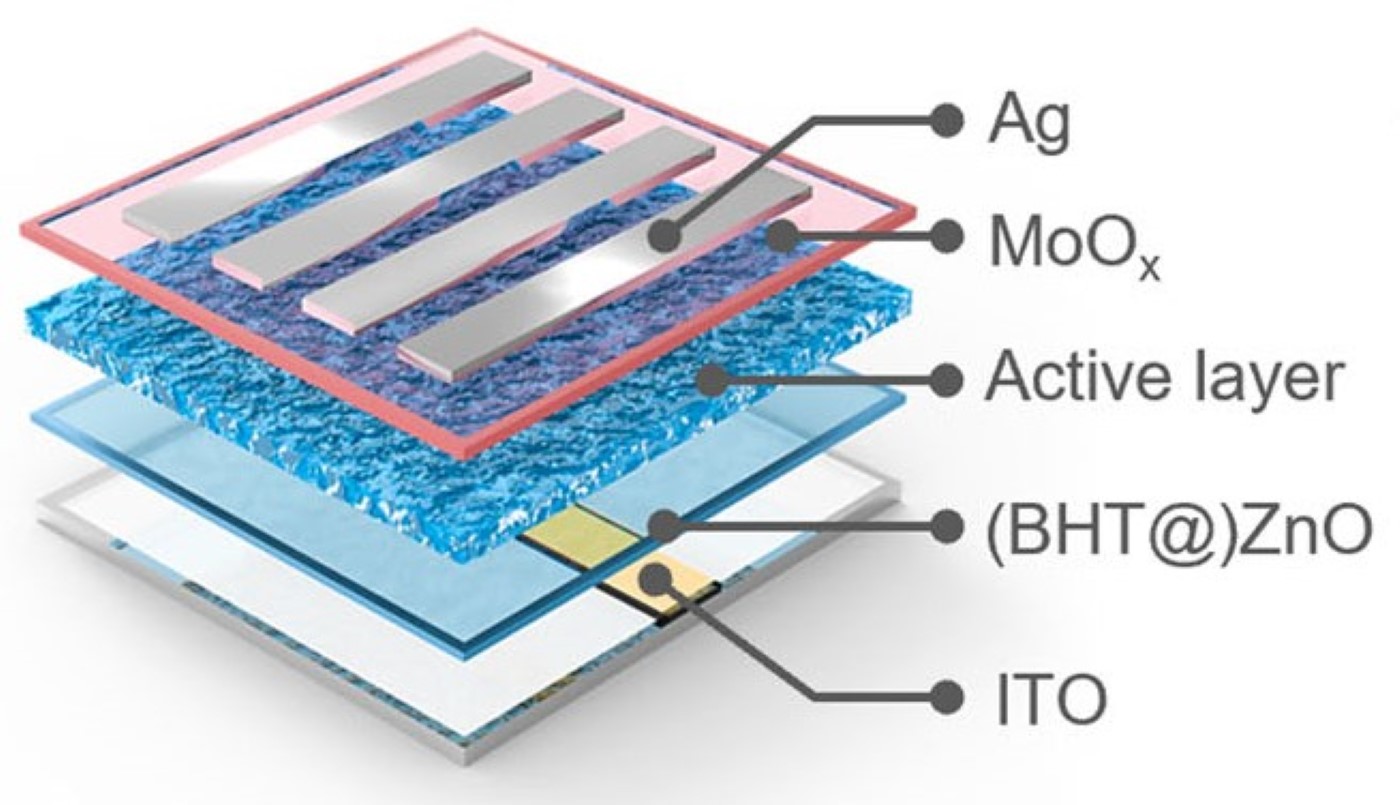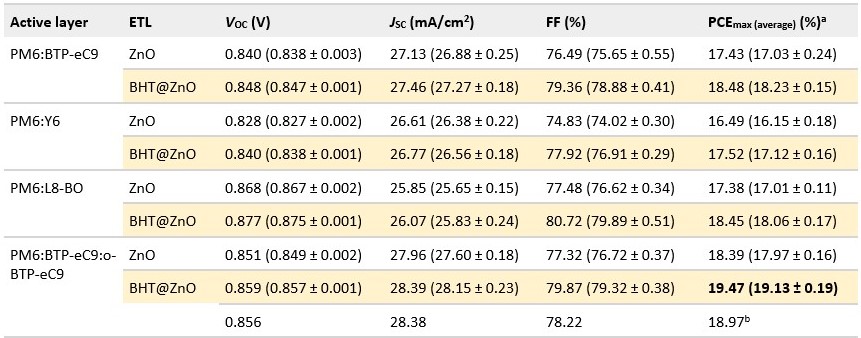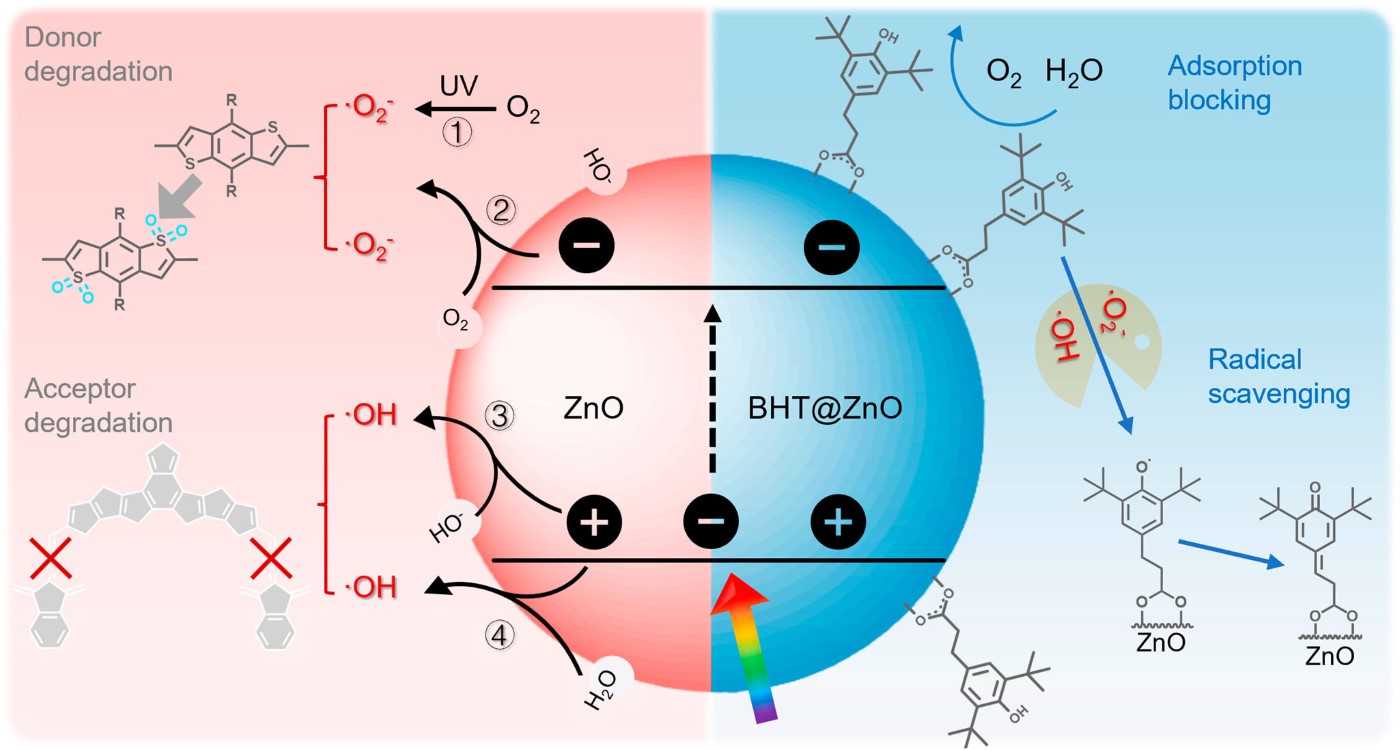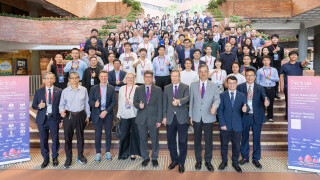Novel Radical Scavenger in Inverted Organic Photovoltaics to Enhance Solar Energy Harvesting

BHT@ZnO-based empowered device achieves a remarkable iOPV efficiency of 19.5% and exhibits long-term stability
Study conducted by Prof. Gang LI and his research team

Organic photovoltaics (OPVs) are a type of solar cell technology that utilises organic materials, typically polymers or small molecules, to convert sunlight into electricity. In comparison to traditional silicon-based solar panels, OPVs offer several advantages, including flexibility, lightweight construction, non-toxicity, transparency, and the potential for low-cost production through roll-to-roll printing processes. These characteristics make OPVs particularly attractive for applications on flexible surfaces, in portable devices, or in building-integrated photovoltaics where aesthetic integration is important. With the very considerable amount of research conducted in the past two decades, the efficiency of OPVs in converting solar energy into electricity has been improved from 16.4% in 2019 to 19.2% in 2023 (in terms of power conversion efficiency (PCE)) [1]. Reported in a previous study, a research team led by Prof. Gang LI, Sir Sze-yuen Chung Professor in Renewable Energy and Chair Professor of Energy Conversion Technology, Department of Electrical and Electronic Engineering at The Hong Kong Polytechnic University, further excelled the efficiency of OPVs to a height of 19.9% (19.5% certified by Asymptotic Pmax Scan Note1) [2].
The organic materials used in OPVs can degrade over time when exposed to environmental factors such as oxygen, moisture, and UV light, imposing a challenge in maintaining their stability and lifespan. To address this challenge, recent research has focused on inverted organic photovoltaics (iOPVs), a variation of OPVs that features a reversed layer structure compared to conventional OPVs Note2, which in theory offers better protection of the active layer from environmental degradation and enhances device longevity. However, the inverted devices tend to exhibit relatively lower PCE compared to regular devices. The emergence of reactive radicals generated through device degradation processes could damage the active layer and other components, leading to a decline in performance.
In a recent study published in Nature Communications, Prof. Li and his research team proposed a novel radical scavenger Note3 that upscales the performance of iOPV and elucidated a detailed degradation mechanism in OPVs [3]. They designed radical scavenger 3-(3,5-Di-tert-butyl-4-hydroxyphenyl)propionic acid (BHT-acid) capped zinc oxide (ZnO) nanoparticles (BHT@ZnO NPs), to provide a multifunctional solution. The synthesis of BHT@ZnO nanoparticles begins with the combination of BHT-acid with ZnO nanoparticles (Figure 1). The researchers prepared ZnO nanoparticles through a method of chemical synthesis and subsequently introduced BHT onto the surface of the ZnO.

Figure 1. Synthesis route of ZnO and BHT@ZnO NPs
a) The synthesis of zinc oxide nanoparticles was carried out according to a known method in the literature as a control for comparison, while for the BHT@ZnO NPs, the surface modification of ZnO involved binding it with BHT-acid. The carboxylate group enables BHT to anchor on the surface of ZnO.
b) The BHT-liganded ZnO nanoparticles demonstrated high uniformity and an average size of approximately 8 nm based on transmission electron microscopy (TEM) images.
The newly developed iOPV device is fabricated with the configuration of ITO/ZnO (BHT@ZnO)/active layer/MoO3/Ag (Figure 2). The use of BHT@ZnO nanoparticles as the electron transport layer (ETL) exhibits their remarkable properties and performance enhancements. The device has higher PCE, improved open-circuit voltage (Voc), higher short-circuit current density (Jsc) and enhanced fill factor (FF, defined as the ratio of the maximum power output of the solar cell to the product of its Voc and short-circuit current), significantly surpassing the performance of the control devices that typically utilise unmodified ZnO, a benchmark material for ETL (Table 1). When applying PM6:BTP-eC9:o-BTP-eC9 as the active layer Note4, the BHT@ZnO device achieves a new record iOPV PCE of 19.47% PCE and a certified PCE of 18.97%, comparable to the record for regular OPV devices [1 & 2].

Figure 2. Device structure of inverted OPV
Table 1. Photovoltaic parameters of the inverted OPV based on ZnO and BHT@ZnO with different active layer systems

a Average PCEs with standard deviation calculated from 20 devices. All devices were tested with a metal mask applied.
b Certificated by Enli Tech Optoelectronic Calibration Lab (ISO/IEC 17025:2017 accredited Calibration Lab).
In addition to its impressive efficiency, the device demonstrates exceptional stability. It maintains 94.2% of its initial PCE after being stored in ambient dark conditions for over 8,904 hours and retaining 81.5% of initial efficiency under maximum power point tracking, for over 7,724 hours Note5. These performance metrics highlight the potential of BHT@ZnO as a promising ETL material for the future design of active layer materials.
The research team conducted an in-depth investigation into the degradation mechanisms of the active layer materials of PM6:BTP-eC9 in OPV devices under light exposure. The team discovered opposing degradation trends of the donor (PM6) and acceptor (BTP-eC9) materials, with BTP-eC9 degrading more rapidly in a nitrogen atmosphere, while PM6 showed faster degradation in air, with the existence of ZnO. This differential degradation behaviour was attributed to the selective catalytic effects of reactive oxygen species (ROS) Note6 which is generated by light-induced ZnO. Specifically, superoxide radicals (·O2-) and hydroxyl radicals (·OH), which were found to induce distinct degradation pathways for each material. Through their analysis, the researchers identified that the oxidation of the benzodithiophene (BDT) unit in PM6, primarily driven by ·O2-, is a critical step leading to its degradation. Conversely, the degradation of BTP-eC9 was closely linked to the oxidative effects of ·OH.
Figure 3 presents four potential mechanisms of ROS generation in ZnO under light illumination that leads to degradation of the active layer of the iOPV device. The research team further found that BHT@ZnO could effectively suppress the ROS, including ·O2- and ·OH. The carboxyl group in BHT-acid effectively passivates the oxygen vacancies on the surface of ZnO to reduce ROS generation. In addition, BHT@ZnO can scavenge the generated ROS, thus enhancing the performance of the iOPV device. This comprehensive understanding of the degradation mechanisms, together with the performance enhancement of the BHT@ZnO-based iOPV device, provides valuable insights for the design of more stable and efficient OPV materials and paves the way for the commercialisation of high-efficiency and long-lasting organic photovoltaic technologies for light harvesting.

Figure 3. Schematic diagram of the degradation behaviour of active layers on ZnO and the working mechanism of BHT@ZnO in improving the stability of OPV
Left (red area): Four potential mechanisms of reactive oxygen species (ROS) generation in ZnO under light illumination, along with the degradation pathways of both the BDT-based donor and non-fullerene acceptors (NFA) small molecule acceptor catalysed by ·O2− and ·OH, respectively.
Right (blue area): Surface passivation of ZnO by BHT and its effects on reducing O2/H2O adsorption and scavenging ROS.
Prof. Li was named a “Highly Cited Researcher” by Clarivate Analytics for eleven consecutive years from 2014 to 2024. He was ranked among the top 2% most-cited scientists worldwide (for career-long) by Stanford University in the field of nanoscience and nanotechnology for five times during 2019 to 2024. Prof. Li was awarded the inaugural RGC Senior Research Fellowship in 2022, and he was elected as a Fellow of the Optica (2022), Fellow of SPIE (2019) and Fellow of Royal Society of Chemistry (2018) for his seminal and sustained contributions to the research and development of organic solar cells and perovskite solar cells.
| Notes |
|---|
A standard evaluation method for the thin film photovoltaics, which was proposed by the National Renewable Energy Laboratory's Cell and Module Performance Group.
At the bottom of the inverted OPV structure is the transparent conductive oxide which serves as the cathode. Directly above this is the electron transport layer (ETL) which facilitates the efficient extraction and transport of electrons from the active layer to the cathode. The active layer, a blend of donor and acceptor materials, is where light absorption and exciton generation occur. Above the active layer, the hole transport layer (HTL) or p-layer is positioned to transport holes to the anode. An inter-layer may be introduced between the active layer and the HTL to improve energy level alignment and charge separation, thereby reducing recombination losses. Finally, the anode, typically made of a metal, completes the device structure.
This is used to neutralise reactive radicals generated during operation of iOPV device.
The PM6:BTP-eC9:o-BTP-eC9 active layer is a ternary blend composed of a donor polymer (PM6) and two non-fullerene acceptors (BTP-eC9 and o-BTP-eC9). This combination is designed to achieve better light harvesting, increase power conversion efficiency, and improve stability compared to traditional binary blends.
An ambient environment at room temperature and a relative humidity of 20–30%, following the ISOS-D-1 and ISOS-L-1 testing protocols, was used respectively.
ROS are highly reactive molecules containing oxygen. These species can form during the operation of OPV devices, particularly under illumination and in the presence of oxygen and moisture.
References |
|---|
[1] National Renewable Energy Laboratory. (n.d.). Best research-cell efficiency chart. Retrieved January 6, 2025, from https://www.nrel.gov/pv/cell-efficiency.html
[2] Fu, J., Yang, Q., Huang, P., Chung, S., Cho, K., Kan, Z., Liu, H., Lu, X., Lang, Y., Lai, H., He, F., Fong, P. W. K., Lu, S., Yang, Y., Xiao, Z., & Li, G. (2024). Rational molecular and device design enables organic solar cells approaching 20% efficiency. Nature Communications, 15(1), 1830–1830. https://doi.org/10.1038/s41467-024-46022-3
[3] Huang, J., Fu, J., Yuan, B., Xia, H., Chen, T., Lang, Y., Liu, H., Ren, Z., Liang, Q., Liu, K., Guan, Z., Zou, G., Chandran, H. T., Lo, T. W. B., Lu, X., Lee, C.-S., Yip, H.-L., Peng, Y.-K., & Li, G. (2024). 19.5% Inverted organic photovoltaic with record long-lifetime via multifunctional interface engineering featuring radical scavenger. Nature Communications, 15(1), 10565–14. https://doi.org/10.1038/s41467-024-54923-6
| Prof. Gang LI Sir Sze-yuen Chung Endowed Professor in Renewable Energy Chair Professor of Energy Conversion Technology, Department of Electrical and Electronic Engineering Joint Director of the Guangdong-Hong Kong-Macao Joint Laboratory for Photonic-Thermal-Electrical Energy Materials and Devices Associate Director of the Otto Poon Charitable Foundation Research Institute for Smart Energy |





